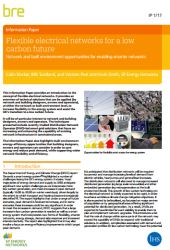Flexible electrical networks for a low carbon future: Network and built environment opportunities for enabling smarter networks
BRE (Building Research Establishment) is an independent, research-based consultancy, testing and training organisation, operating in the built environment and associated industries.
Flexible electrical networks for a low carbon future: Network and built environment opportunities for enabling smarter networks (IP 1/17) was written by Colin Sinclair, and published by BRE Scotland on 10 April 2017.
Equipment that delivers electricity to properties will need to be increasingly agile to meet energy demand requirements and assist in the transition to a low-carbon future. This will become crucial as low-carbon technology may increase peak network flows with surges in system voltage.
This information paper provides an introduction to the concept of flexible electrical networks. It offers an overview of technical solutions that can be applied by network and building designers, owners and operators, at either the network or built environment level, to increase flexibility in the energy system. It describes techniques tested in Scotland under the Flexible Networks for a Low Carbon Future project. It explains innovative technical solutions used to increase energy flexibility and to maintain network integrity and customer supply and service. This includes Distribution Network Operator (DNO)-led smart grid solutions that focus on increasing and enhancing the capability of existing network infrastructure in constrained areas.
The contents of the information paper are:
- Introduction.
- What is a flexible network?
- Enhanced network monitoring.
- Innovative techniques.
- Where to apply these techniques.
[edit] Find out more.
[edit] Related articles on Designing Buildings Wiki
- BRE articles on Designing Buildings Wiki.
- Building Research Establishment.
- Developing system intelligence for optimising building electricity networks.
- Electricity supply.
- Energy infrastructure.
- Energy storage.
- Microgeneration.
- Micro-grid.
- Renewable energy.
- Smart grid.
- Smart meter.
- The Future of Electricity in Domestic Buildings.
Featured articles and news
Government consultations for the summer of 2025
A year of Labour, past and present consultations on the environment, the built environment, training and tax.
CMA competitiveness probe of major housing developers
100 million affordable housing contributions committed with further consultation published.
Homes England supports Greencore Homes
42 new build affordable sustainable homes in Oxfordshire.
Zero carbon social housing: unlocking brownfield potential
Seven ZEDpod strategies for brownfield housing success.
CIOB report; a blueprint for SDGs and the built environment
Pairing the Sustainable Development Goals with projects.
Types, tests, standards and fires relating to external cladding
Brief descriptions with an extensive list of fires for review.
Latest Build UK Building Safety Regime explainer published
Key elements in one short, now updated document.
UKGBC launch the UK Climate Resilience Roadmap
First guidance of its kind on direct climate impacts for the built environment and how it can adapt.
CLC Health, Safety and Wellbeing Strategy 2025
Launched by the Minister for Industry to look at fatalities on site, improving mental health and other issues.
One of the most impressive Victorian architects. Book review.
Common Assessment Standard now with building safety
New CAS update now includes mandatory building safety questions.
RTPI leader to become new CIOB Chief Executive Officer
Dr Victoria Hills MRTPI, FICE to take over after Caroline Gumble’s departure.
Social and affordable housing, a long term plan for delivery
The “Delivering a Decade of Renewal for Social and Affordable Housing” strategy sets out future path.
A change to adoptive architecture
Effects of global weather warming on architectural detailing, material choice and human interaction.
The proposed publicly owned and backed subsidiary of Homes England, to facilitate new homes.
How big is the problem and what can we do to mitigate the effects?
Overheating guidance and tools for building designers
A number of cool guides to help with the heat.
The UK's Modern Industrial Strategy: A 10 year plan
Previous consultation criticism, current key elements and general support with some persisting reservations.
Building Safety Regulator reforms
New roles, new staff and a new fast track service pave the way for a single construction regulator.


























